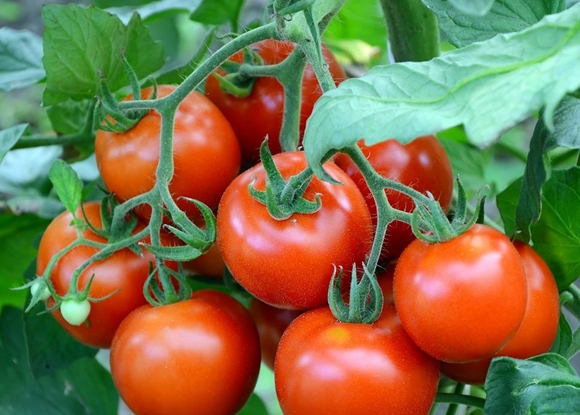 More and more gardeners are choosing hybrid tall tomato varieties for their plots. Hybrids are highly resistant to all kinds of diseases, give a good harvest, and the fruits have excellent taste.
More and more gardeners are choosing hybrid tall tomato varieties for their plots. Hybrids are highly resistant to all kinds of diseases, give a good harvest, and the fruits have excellent taste.
Hybrid tomato variety “Good F1” has incorporated all these characteristics.
Content
Grade Features
The tomato variety Dobry refers to indeterminate plants, that is, the bush does not stop its growth throughout the entire period of development and fruiting and often grows up to two meters in height. Long, strong stems are densely covered with large dark green leaves, slightly rough at the edges.
The fruits of Good Tomato are round, medium in size, and weigh up to 180 grams. The peel is thick, smooth, shiny, in the stage of technical ripeness is painted in a light green color, and upon reaching biological maturity it turns bright red
The pulp of tomatoes is dense, fleshy, with a small amount of seeds. Due to the high sugar content, tomatoes have a slightly sweet taste.
The variety is great for fresh consumption, and also because of the optimal shape and thick walls, tomatoes are often used for whole-pickled salting.
Good tomato belongs to the group of medium late varieties. Tomatoes begin to ripen only four months after sowing the seeds. Therefore, it is recommended to grow this variety in a greenhouse, because, growing in open ground, tomatoes do not have time to ripen by time.
Variety Good - a high-yielding hybrid. Tomatoes have a medium-late ripening period, that is, plants begin to bear fruit by the end of July, 130 days after sowing seeds. Brushes form fruits until October. Each bush brings on average up to five kilograms of delicious selected tomatoes.
As befits hybrids, the variety Good is protected by immunity from all kinds of diseases that often affect tomato bushes.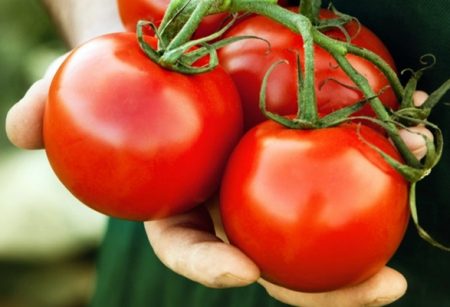
Grade Advantages
- high yielding;
- not sick with fusarium and viral mosaic;
- takes up little space in the greenhouse, as it grows up, and not in breadth;
- numerous brushes, which are formed up to forty pieces produce twice as many fruits than undersized tomatoes;
- buds and fruits are formed within a few months, which allows you to enjoy the great taste of fresh tomatoes for a long time;
- the fruits have an optimal shape for conservation;
- great taste of tomatoes;
- keeping time reaches 30 days.
Grade Cons
- the vegetative part ripens for a long time;
- the first fruits appear a month later than in varieties with limited growth;
- not suitable for outdoor cultivation;
- the need for the formation of a bush and constant stepsoning;
- Only purchased seeds are suitable for cultivation, as harvested seeds will not have the same positive characteristics.
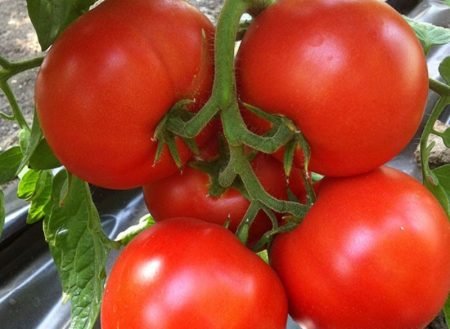
Growing Features
This tomato variety can be grown only through seedlings - this is the only way to achieve high quality fruits. Sowing seedlings is carried out two months before the alleged planting in greenhouse soil.
Purchased seeds usually have already gone through external “selection”. This means that all the seeds are ready for planting. But before they need to be slightly prepared, so that the first shoots appear as soon as possible. Seeds are soaked in water so that they swell. Then the seed is disinfected with infusion of manganese. After processing, the seeds must be washed and thoroughly dried. For hardening, the seeds are placed first in heat (for a day), and then in cool conditions. For better germination, the seeds are treated with a growth stimulant (Epin, Zircon preparations).
The soil mixture must also be prepared. It is preferable to plant tomatoes in loose, airy, drained soil.
Soil composition:
- Earth;
- humus;
- ash.
The earth is also disinfected by warming it to 55 degrees with a microwave or oven.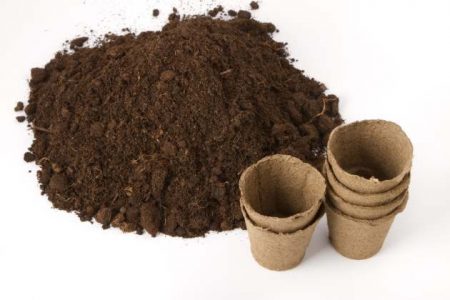
Tomato seeds are planted in boxes, seeding each seed to a depth of 1-1.5 centimeters and at a distance of two centimeters from each other. The boxes are covered with a film until the first shoots appear. The optimum temperature for germinating seedlings is 24 degrees heat. Since at the beginning of spring a sunny day is small, the seedlings need to be provided with additional lighting. As soon as the first shoots hatch, the amount of sunlight is increased to 16 hours a day.
The next two weeks, seedlings sprout in absolute peace: in warmth and light. Periodically, the seedlings are watered with warm, settled water, and they also make ventilation so that the moisture does not stagnate. With the advent of two fully opened leaves, seedlings are dived, that is, each bush is planted in separate cups.
All the time remaining before planting tomatoes on the bed, the seedlings need to be watered and fed. After the picking, another month will pass before the moment the tomatoes are transplanted to a permanent place.
Vegetables are usually planted in a greenhouse earlier than in open ground. Therefore, tomato bushes are transferred to the greenhouse at the end of April. There, seedlings await transportation for another 10-12 days, at the same time being tempered by a lowered ambient temperature. As soon as the frosts are left behind, seedlings are planted on the garden. A separate hole is prepared for each plant, the distance between which is 40 centimeters. At least 50 centimeters are left on the aisle. Holes close up with a depth of 15 centimeters.
Organics in the form of humus and ash, as well as complex mineral fertilizers, are laid at the bottom of the holes. At first, plants will especially need nitrogen, potassium and phosphorus, and therefore these components should be a priority. After planting, the earth is rammed around the stem, and the bushes are sprayed with Bordeaux liquid (100 grams of substance per 10 liters of water) and watered abundantly. Immediately you need to install supports, since garters will be needed almost immediately.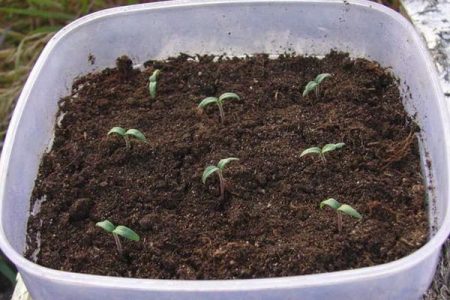
Care
For the tall variety Good, special care is required, which consists in regular stepsoning. The plant is formed mainly in one stem, that is, all side branches and stepsons are removed from the tomato, leaving only the main trunk. Excess shoots take themselves most of the nutrients, preventing the central stem and the brushes that form the fruits from developing. In addition, stepsons make the bush too leafy, which interferes with the normal circulation of air. Thickening of plantings leads to stagnation of moisture, and as a result of the development of fungal diseases.
The main problem in caring for plants of such sizes as Good tomato is that the bushes must be constantly tied up. In growing tomatoes you need to use a trellis - two metal stakes are installed at different ends of the beds on which the thread is pulled first at a height of 30 centimeters from the ground. With the growth of plants, a new filament layer is pulled, to which the bushes are tied. The higher the plant grows, the more layers of thread will have to be done.
In a greenhouse, it is more difficult to monitor the level of humidity, because unlike an open area, a greenhouse is more difficult to ventilate. Because of this, the greenhouse environment is often waterlogged, which makes plants feel worse and grow accordingly slower. Therefore, it is so important to provide greenhouse plantings with a fresh influx of air. To do this, the doors of the calf should be located on both sides, so that the air can freely "walk".
Increasingly, gardeners, growing tomatoes in greenhouses, use mulch. Mulching the land under the bushes allows moisture to stay in the ground longer, respectively, watering plantings is much less common.
Basic rules for the care of tomatoes grown in a greenhouse
- water the plants once a week, pouring water under the root and without affecting the leaves;
- carry out regular ventilation, while avoiding the creation of weeds;
- regularly loosen, weed the soil, both under the bushes and between the beds;
- to form plants in one or two stems;
- remove lower leaves that are close to the ground;
- to plant bushes only in the morning, so that the wounds have time to dry by evening;
- spend at least three top dressings for the entire season. In the first month, a solution of mullein and fermented grass is brought into the ground. Minerals, in particular nitrogen-containing preparations, are also added;
- after flowering, nitrogen supplementation is reduced, increasing potassium and phosphorus compounds.
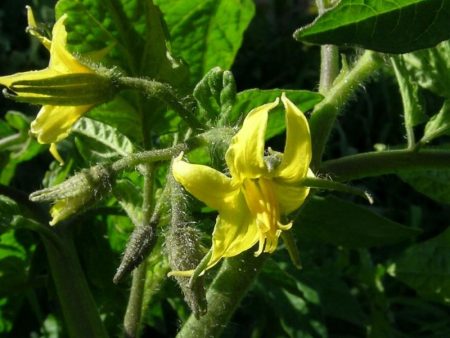
Greenhouse plants require much more nutrition than those that grow in open beds. Therefore, tomatoes regularly need new servings of fertilizing.
Diseases and Pests
Hybrid tomato varieties are very rarely ill. They are almost never affected by diseases such as fusarium, tobacco mosaic and so on. However, growing in a greenhouse, in conditions of high humidity, tomato bushes can pick up such an unpleasant and insidious disease as late blight. This disease is manifested by the appearance of brown spots with a light green border along the edge of the stems and fruits. A white coating appears under the leaf. These spores quickly migrate to neighboring plants. As a result of the effects of fatal spores, inflorescences and peduncles die. If there are signs of late blight, then you need to immediately remove the affected areas of the plant and treat the affected bush with Oxychoma, Hom, Bordeaux fluid, Albit, etc. In order to prevent the development of this disease, Fitosporin is used or the beds are treated with copper-containing preparations.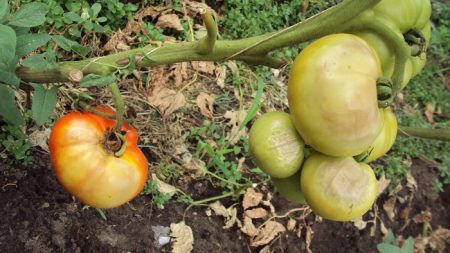
The main measures for the prevention of late blight of tomatoes
- carry out regular autumn cultivation of the greenhouse and the earth;
- disinfect the greenhouse frame with a solution of laundry soap and water;
- observe crop rotation;
- Do not plant plants too thickly;
- regularly ventilate the greenhouse, prevent stagnation of water;
- fertilize the soil with potash and phosphorus fertilizers;
- to process the earth with lime and dolomite flour.
Following these guidelines will help reduce the development of harmful fungal bacteria.
Land cultivation also helps to get rid of all kinds of pests that inhabit greenhouses and love to feast on the roots, stems, and fruits of tomatoes. Often, tomato bushes affect slugs, spider mites and the Colorado potato beetle. You can poison insects with chemicals or folk remedies - spray the bushes with infusion of dandelion, garlic and hot pepper.
Reviews
Marina
A good hybrid variety, grown it last year.The bushes grew about one and a half meters high, in August I pinched the top, as the height of the greenhouse did not allow tomatoes to grow higher already. About 12-14 brushes formed on each bush. Each brush gave 7-9 tomatoes. The fruits pleased both the taste and the look. They ate them all August and September. Tomatoes ripened directly on the bush, they were not torn green. Only before the onset of cold weather cut off all the fruits (including green). Tomatoes ripened quickly, did not deteriorate.
Alexey
I heard a lot about this variety that it is unpretentious enough for tall tomatoes, so I decided to try it in my garden. It turned out that the tomato hybrid "Good" is very fruitful, the crop pleased me. The taste of tomatoes is very decent, sweet, juicy.
I liked the fact that the bushes did not hurt. I didn’t process with special preparations, I mainly used folk remedies. I took tomatoes from the branches still brown, they very quickly reached the windowsill. During this time, new fruits again formed in empty places. The tomato bears fruit for a very long time, somewhere from mid-summer to the end of September for sure. Very good grade! I recommend!
Natalya
Tomatoes are always grown in the open ground, and last year they installed a greenhouse in the garden, so I decided to try something new in the new season, to grow an unusual tall tomato variety for me. I used to always grow low tomatoes, so I honestly doubted the success of the enterprise, planting a “Good” variety for seedlings. I was also afraid that it would be much harder to take care of him. However, everything turned out much more successfully. Firstly, the seedlings sprouted very well. By the time of planting, the bushes were 25 centimeters long, had strong stems and buds were already forming on the branches. Secondly, the landing of the tomatoes was endured steadily. Maybe the comfortable temperature affected that moment, or maybe it's a feature of the variety. The plants were waved very large, under two meters. I formed them into two stems. Thirdly, a lot of brushes were formed, each brush by the end of July was strewn with medium-sized tomatoes. Each tomato is an average of 150 grams. There were no flaws in appearance, everything was just like a selection. She noted the good keeping quality of the fruit. They lie for a very long time, neither taste nor appearance spoils. In general, I was incredibly glad that I chose this particular variety for the debut, which did not disappoint.




 Low-growing tomatoes, without pinching: 5 of the most delicious varieties
Low-growing tomatoes, without pinching: 5 of the most delicious varieties Why tomato seedlings grow poorly
Why tomato seedlings grow poorly We grow a tomato in a shell
We grow a tomato in a shell Growing tomatoes without watering according to the method of Kazarin
Growing tomatoes without watering according to the method of Kazarin